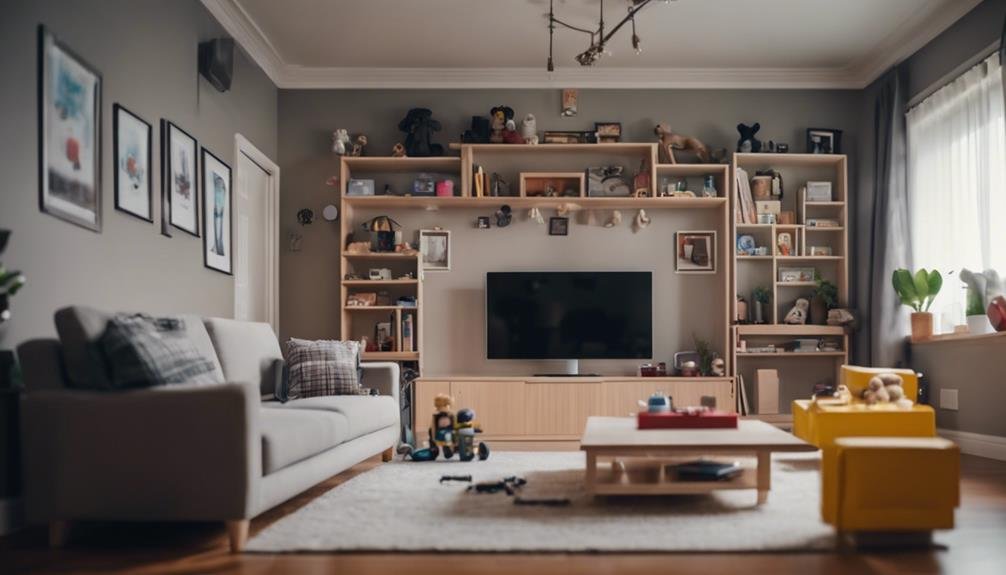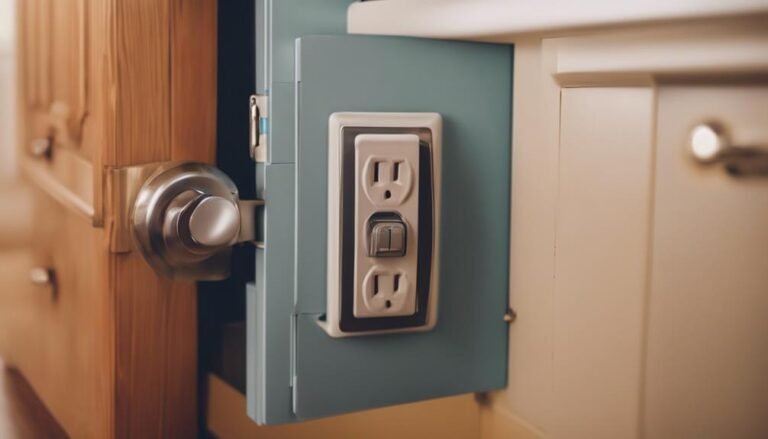How to Create a Safe Home Environment for Toddlers
Imagine creating a haven where your toddler can explore freely without encountering potential hazards at every turn. Ensuring a safe home environment for your little one involves more than just childproofing the obvious corners and edges. From securing furniture and electrical outlets to having a well-thought-out emergency plan, every detail plays a vital role in keeping your child safe. But what about the less obvious dangers that might lurk in plain sight? Let's uncover the layers of creating a truly safe space for your toddler to thrive.
Key Takeaways
- Secure cabinets and electrical outlets with safety features.
- Choose furniture with rounded edges and secure heavy items.
- Install safety gates and supervise near water sources.
- Check for hazards regularly and childproof your home.
- Have an emergency plan, first aid kit, and safe toys.
Importance of Childproofing
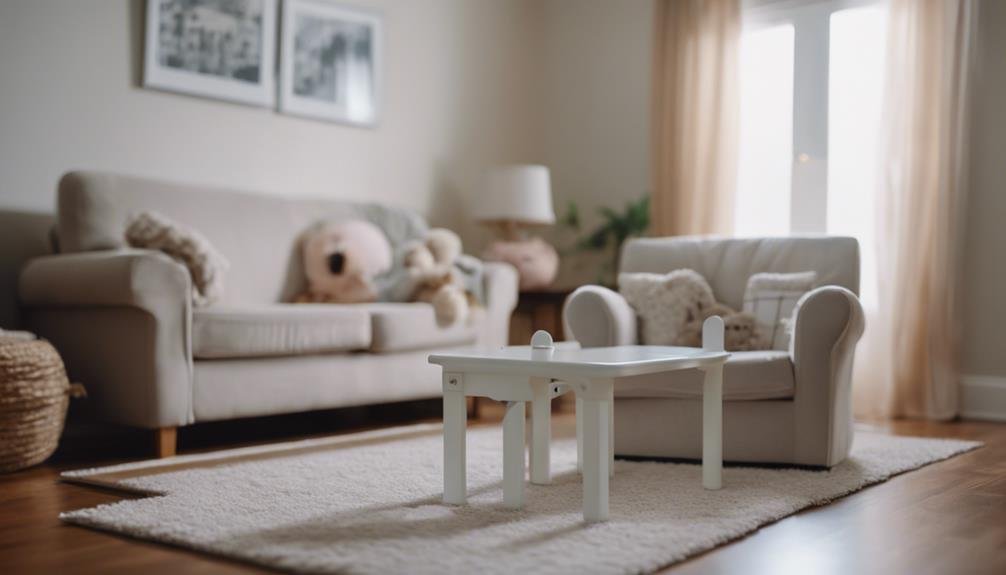
To ensure the safety of your toddler, childproofing your home is essential.
Start by securing cabinets and drawers with safety latches to prevent your little explorer from accessing potentially harmful items like cleaning supplies or sharp objects.
Cover electrical outlets with safety plugs to avoid any accidents.
Install safety gates at the top and bottom of stairs to prevent falls, and make sure they're securely fastened.
Keep small objects that could be choking hazards out of reach, and consider securing furniture to the walls to prevent tipping.
Be mindful of blind cords, which pose a strangulation risk, and either cut them short or use cord wind-ups to keep them out of reach.
Safe Furniture Choices
Consider selecting furniture with rounded edges and corners to minimize the risk of injuries to your toddler in your home. Opt for sturdy pieces that won't easily tip over when your little one decides to climb.
When choosing a crib, ensure the slats are no more than 2-3/8 inches apart to prevent tiny heads from getting stuck. Look for dressers and bookshelves that are anchored to the wall to prevent them from toppling.
Sofas and chairs with slipcovers are great, as you can easily remove and wash them if spills or accidents occur. Avoid furniture with sharp corners or glass surfaces that can shatter. Additionally, keep furniture away from windows to prevent climbing accidents.
Hazard Identification and Removal
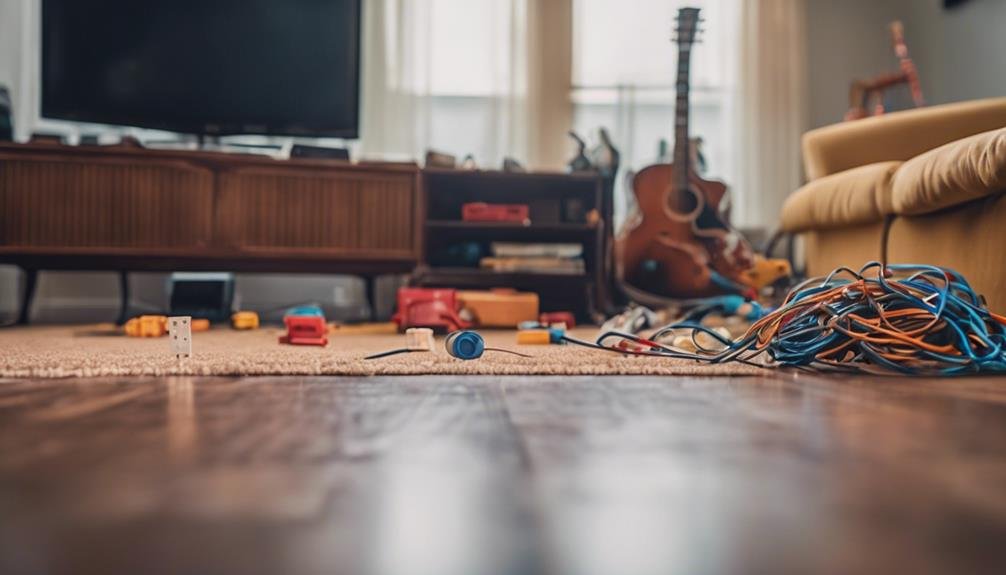
Inspect your home thoroughly to identify and eliminate potential hazards that could pose a risk to your toddler's safety. Start by checking for small items that could be choking hazards, such as coins, buttons, or small toys. Keep these out of reach or stored away securely.
Look for sharp edges on furniture or countertops that your child could bump into and consider adding corner guards to prevent injuries. Secure heavy furniture to the wall to prevent tipping accidents.
Be mindful of blind cords, electrical cords, and curtain ties that could pose a strangulation risk – keep these out of reach or use cord shorteners. Check for slippery surfaces like polished floors or rugs that could cause slips and falls; consider adding non-slip mats.
Ensure all cleaning products, medications, and sharp objects are stored in locked cabinets or high out of reach. Regularly inspect your home for new hazards and address them promptly to maintain a safe environment for your toddler.
Electrical Safety Measures
Ensure all electrical outlets are childproofed with outlet covers to prevent your toddler from inserting objects into them. This simple step can prevent accidents and keep your little one safe.
Make sure that all cords are tucked away and out of reach to avoid tripping hazards or the temptation to pull on them. Use cord shorteners or wind up excess cord length to prevent your toddler from playing with them.
Remember to unplug appliances when not in use and teach your child the importance of not touching electrical items.
Consider installing tamper-resistant outlets that require a stronger push to insert plugs, adding an extra layer of protection.
Regularly inspect cords for any damage and replace them if needed. If you have any concerns about the electrical wiring in your home, consult a professional electrician to ensure everything is up to safety standards.
Preventing Accidental Poisoning
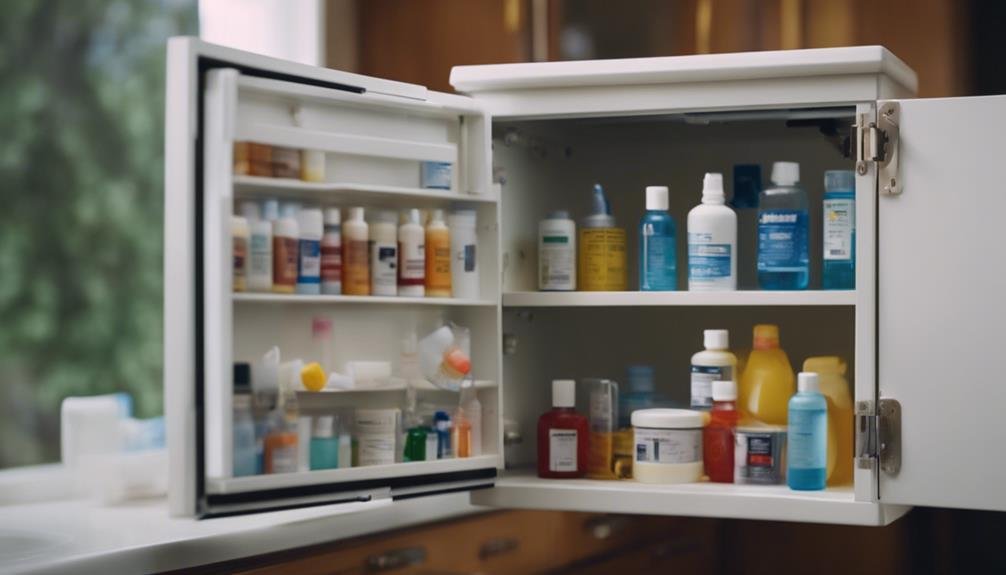
To protect your toddler from accidental poisoning, store all household cleaning products and medications in locked cabinets or high shelves out of reach. Accidental ingestion of chemicals or medications can be dangerous for your little one. Here are some practical tips to prevent accidental poisoning:
- Childproof Your Home: Install safety latches on cabinets where you store cleaning products and medications to prevent your toddler from accessing them.
- Proper Labeling: Ensure all cleaning products and medications are clearly labeled. Avoid transferring them to unmarked containers to prevent confusion.
- Safe Disposal: Dispose of expired or unused medications properly. Take them to a pharmacy or local hazardous waste facility for disposal.
- Emergency Numbers: Keep important numbers handy, such as the Poison Control Center (1-800-222-1222), in case of accidental ingestion. Immediate action is crucial in such situations.
Water Safety Precautions
Keep your toddler safe around water by implementing essential water safety precautions at home. Always supervise your little one around any water source, whether it's a bathtub, pool, or even a bucket of water.
Empty all containers immediately after use to prevent any accidental drowning incidents. Install safety locks on toilet lids to prevent toddlers from falling in. Consider putting up barriers around pools or ponds to restrict access when not in use.
Teach your child basic water safety rules, such as not running around pool areas and never swimming alone. Additionally, enroll your toddler in swimming lessons to help build their confidence and skills in the water.
Remember to keep all water-related items out of reach when not in use, including toys that could tempt your curious toddler. By following these simple yet crucial water safety precautions, you can create a secure environment for your toddler to enjoy water activities safely.
Secure Window and Door Locks
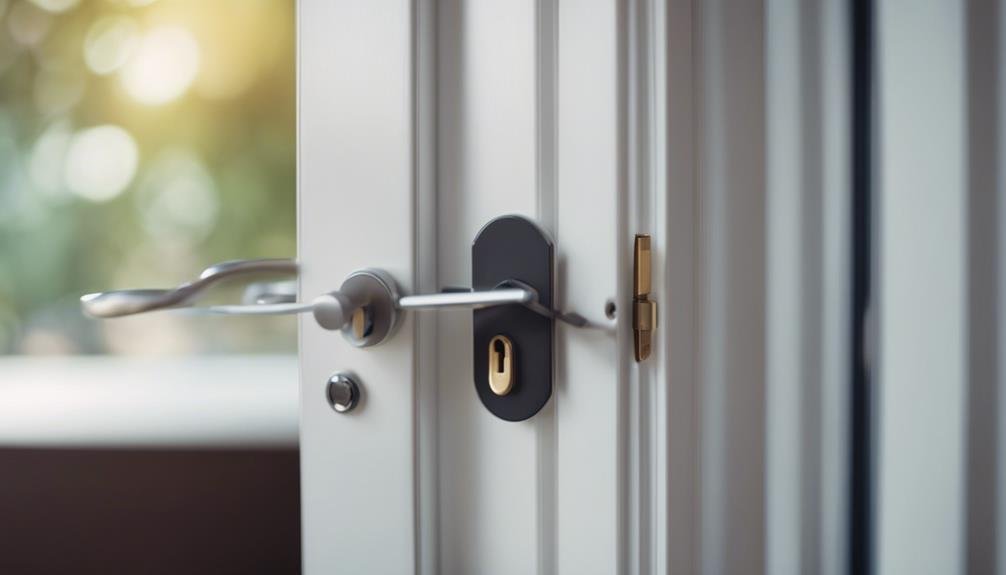
For enhanced home safety, reinforce window and door locks to prevent unauthorized access and ensure your toddler's security. It's crucial to take the necessary steps to secure your home and keep your little one safe.
Here are four practical tips to help you secure window and door locks effectively:
- Install Window Locks: Place window locks out of your toddler's reach to prevent them from opening windows and risking falls.
- Upgrade Door Locks: Consider installing deadbolts or smart locks on exterior doors to enhance security and prevent easy entry.
- Use Door Alarms: Install alarms on doors leading outside to alert you if they're opened, providing an additional layer of security.
- Regularly Check Locks: Periodically inspect and maintain all locks to ensure they're in good working condition and provide maximum protection for your toddler.
Emergency Preparedness Plan
Developing an effective emergency preparedness plan is essential to ensure your toddler's safety in unforeseen situations. Start by creating a clear plan that includes contact information for emergency services, family members, and neighbors. Make sure to have important documents like insurance papers and medical records easily accessible. Practice fire drills regularly and establish meeting points both inside and outside the house. Teach your toddler basic safety procedures like how to dial emergency numbers and what to do in case of a fire or injury.
It's crucial to have a well-stocked first aid kit readily available in your home. Include essential items like bandages, antiseptic wipes, and children's pain relievers. Familiarize yourself with basic first aid procedures to handle common injuries that toddlers may experience. Additionally, consider taking a CPR and first aid training course to be prepared for more serious emergencies.
Stay informed about potential hazards in your area such as natural disasters or community risks. Keep emergency supplies like non-perishable food, water, and flashlights in a designated location. Regularly review and update your emergency preparedness plan to ensure its effectiveness in keeping your toddler safe.
Safe Toy Selection
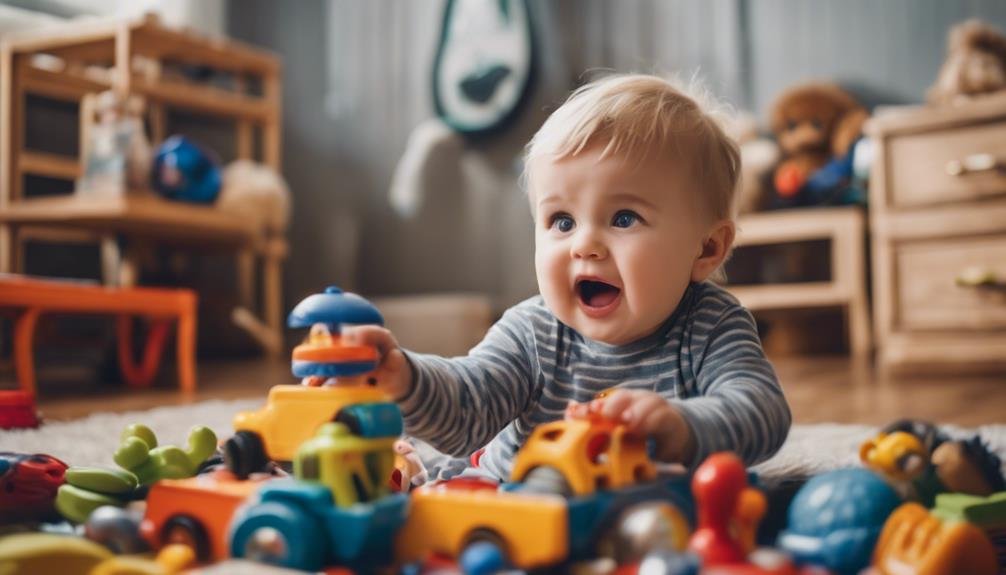
To ensure your toddler's safety, carefully select toys that are age-appropriate and free of choking hazards. When choosing toys, keep in mind your child's developmental stage and interests. Here are some tips to help you make safe toy selections:
- Check for age recommendations: Always look for the age recommendation on the toy packaging. This ensures that the toy is suitable for your toddler's developmental stage.
- Inspect for small parts: Avoid toys with small parts that can be detached easily, as they pose a choking hazard. Make sure all parts are securely attached.
- Avoid toys with sharp edges: Opt for toys with smooth edges to prevent cuts or injuries during playtime.
- Consider non-toxic materials: Choose toys made from non-toxic materials to ensure your toddler's safety, especially if they tend to put toys in their mouth.
Supervision and Monitoring
When it comes to ensuring your toddler's safety at home, maintaining constant supervision and monitoring is key. Being present and attentive can prevent accidents and provide a quick response if needed. Here are some practical tips to help you supervise effectively:
| Tip | Description | Importance |
|---|---|---|
| Set up baby gates | Use gates to block off stairs or rooms that are not toddler-proofed. | Prevent falls and access to hazardous areas. |
| Childproof locks | Install locks on cabinets and doors to keep dangerous items out of reach. | Minimize the risk of accidents and poisoning. |
| Safe play spaces | Designate safe areas where your toddler can play freely without hazards. | Encourage independent play in a secure environment. |
Frequently Asked Questions
How Can I Teach My Toddler About Home Safety?
You teach your toddler about home safety by making it a part of your daily routine. Explain rules clearly, use positive reinforcement, and model safe behavior. Practice drills for emergencies and childproof your home to prevent accidents.
Should I Childproof Every Room in the House?
Childproofing every room in the house is essential to keep your little one safe. It may seem daunting, but it's worth the effort. Prevention is key to avoiding accidents. Take the time to secure all potential hazards.
What Are Some Common Household Hazards for Toddlers?
You must be aware of common household hazards for toddlers. Keep an eye out for sharp corners, loose cords, small objects, and cleaning supplies. Secure furniture to walls, cover outlets, and keep hot items out of reach.
Are There Any Childproofing Tips for Outdoor Spaces?
When setting up outdoor spaces for toddlers, ensure fences are secure, and gates have childproof latches. Cover sharp edges with soft padding, and keep small toys and objects out of reach. Supervise playtime and teach safety rules.
How Often Should I Update My Emergency Preparedness Plan?
You should update your emergency preparedness plan at least once a year. Regularly reviewing and making necessary adjustments ensures your plan stays relevant and effective in times of crisis. Stay proactive and keep your loved ones safe.
Conclusion
In the journey of creating a safe home environment for toddlers, remember that you're the captain of the ship, navigating through the waters of potential hazards.
By implementing childproofing measures, safe furniture choices, hazard identification, and constant supervision, you're steering towards a safe harbor for your little ones.
Stay vigilant, be prepared, and keep sailing on the path of safety and security for your precious cargo.

